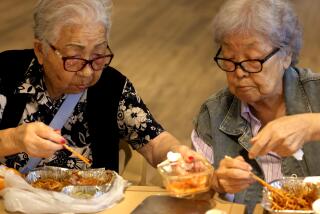THEATER NOTES : East West to Move Into Union Church
- Share via
The former Union Church building in Little Tokyo looks decrepit, even spooky. So much so that John Carpenter used the city-owned structure--built in 1923 but unused as a church since 1979--as a location for his horror film “Prince of Darkness” in the mid-’80s.
Even that use wouldn’t be permitted today--the building is still yellow-tagged as a result of the 1994 earthquake.
By January, 1997, however, East West Players plans to occupy more than half of the building and to open “Pacific Overtures” in a new mid-sized theater on the second floor.
On June 28, East West officials signed a 10-year lease for their portion of the building. Their landlord is the Little Tokyo Service Center, which has its own 44-year lease from the city. Two other arts organizations, the Asian Pacific American media group Visual Communications and L.A. Artcore gallery, will occupy the rest of the building.
The theater will provide room for 167 seats on the main floor and 70 in a balcony. If used to capacity, it will catapult East West, which is about to launch its 30th season, out of the ranks of the many sub-100-seat theater companies and into the arena of those few L.A. companies that use Equity contracts.
This costs money. East West has launched a campaign for $1.5 million. The funds will equip the theater, including an expansion of the tiny altar area into a proscenium stage, and will pay operating expenses for the upgraded company, including office rental in an adjacent building, as well as East West’s share of the building’s expenses.
Artistic director Tim Dang said the latter should be no more than the company is currently paying for its 99-seat theater at a nondescript location near the eastern end of Santa Monica Boulevard.
Little Tokyo Service Center will pay for the actual building renovation, using $3.4 million in city seismic bonds, Community Redevelopment Agency money and private and public grants. The renovation will add dressing rooms and a rehearsal room backstage. The center hopes to use a city-owned parking lot to the north.
Couldn’t East West’s move to Little Tokyo reinforce the view of the company as primarily Japanese American, a designation that company officials have recently tried to overcome?
Dang acknowledged this was a concern of the company’s board. Whether it is justified “depends on the type of programming we do,” he said. “We still have a pan-Asian mission statement.”
In the coming season--slated to be the last season on Santa Monica Boulevard--East West plans to present the West Coast premiere of the latest version of the Stephen Sondheim-George Furth musical “Merrily We Roll Along” (Sept. 14-Nov. 5); a revival of Wakako Yamauchi’s “And the Soul Shall Dance” (Jan. 11-Feb. 18); Chay Yew’s “Half Lives” (March 14-April 28) accompanied by limited runs of Yew’s first two plays in the same trilogy, “Porcelain” and “A Language of Their Own,” and the Los Angeles premiere of Peter Shaffer’s “Lettice and Lovage” (May 23-June 30).
Of these, only “And the Soul Shall Dance” is by a Japanese American.
Erich Nakano, project manager for Little Tokyo Service Center, said the entire Union Church project is being planned as an Asian Pacific American, not a specifically Japanese American, arts center.
The building still looks like a church, with a large cross on the roof and smaller crosses on some walls. Because it’s listed on the National Register of Historic Places and has official status as a city cultural monument, such details cannot be easily altered. However, they probably will be masked with banners and drapes.
If the big cross “had only come down in the earthquake, we wouldn’t have this problem,” Nakano said.
More to Read
The biggest entertainment stories
Get our big stories about Hollywood, film, television, music, arts, culture and more right in your inbox as soon as they publish.
You may occasionally receive promotional content from the Los Angeles Times.










